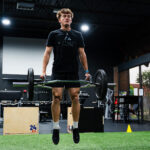Improve Agility with Sports Performance Training
Agility is what allows athletes to change direction, cut quickly, and maintain control of their movements under pressure. It’s not just about moving fast—it’s about moving efficiently and with purpose. That’s why sports performance training that targets agility is essential for competitive athletes.
In this article, you’ll learn how agility works, why it matters, and the best ways to train it effectively.
What Is Agility in Sports?
Agility combines several athletic traits, including:
-
Balance
-
Coordination
-
Reaction time
-
Speed
-
Body control
It’s the ability to change direction quickly without losing speed or stability. In many sports, this skill separates average players from elite performers.
Why Agility Training Matters
Agility gives athletes a major competitive edge:
-
Faster directional changes: Essential in sports like football, basketball, and soccer
-
Improved reaction time: Make quicker decisions under pressure
-
Injury prevention: Good body control helps avoid awkward landings or bad angles
-
Better movement economy: Use less energy to perform the same task
Agility enhances both performance and longevity in sport.
Key Components of Agility Training
To train agility effectively, athletes must work on more than just footwork. Here’s what a complete sports performance training plan includes:
1. Foot Speed and Quickness
Use drills like ladder work and cone taps to increase foot speed. Focus on short, rapid steps and staying light on your feet.
2. Deceleration Control
Learn to stop quickly without losing balance. Use drills like backpedal-to-stop or sprint-stop-hold to teach control under speed.
3. Change-of-Direction (COD) Drills
Work on cutting angles and redirection. Examples include the 5-10-5 drill, T-drill, and pro agility shuttle.
4. Reactive Drills
Use unpredictable cues to simulate real-game changes. Partner-based or coach-directed drills enhance reaction time.
5. Core and Stability Work
A strong core supports balance during sudden movements. Planks, bird dogs, and single-leg stability drills are key.
Top Agility Drills for Athletes
Here are some of the best drills to include in your training sessions:
1. Ladder Drills
How to do it: Use an agility ladder. Move through with high-speed foot patterns (e.g., in-in-out-out, lateral steps).
Purpose: Builds coordination and foot speed.
2. 5-10-5 Shuttle
How to do it: Sprint 5 yards right, then 10 yards left, then 5 yards back to the middle.
Purpose: Enhances rapid changes of direction and acceleration.
3. Cone Box Drill
How to do it: Set cones in a square. Sprint forward, shuffle side, backpedal, and repeat.
Purpose: Trains multi-directional movement and awareness.
4. Mirror Drill
How to do it: Face a partner. One leads with movement, the other mirrors.
Purpose: Builds reactive agility and body control.
5. Single-Leg Hops
How to do it: Hop on one foot over lines or cones in multiple directions.
Purpose: Increases balance, ankle strength, and control.
Weekly Agility Training Template
Here’s a sample agility-focused plan for one week:
| Day | Focus | Example Workout |
|---|---|---|
| Monday | Footwork + Ladder | Ladder drills + single-leg stability |
| Wednesday | COD + Shuttle | 5-10-5 + cone box + deceleration work |
| Friday | Reactive + Core | Mirror drills + planks + bird dogs |
Keep each session under 45 minutes. Focus on quality over quantity.
Mistakes to Avoid in Agility Training
Agility training only works when done with proper technique and purpose. Avoid these pitfalls:
-
Going too fast too soon: Start with good mechanics, then add speed
-
Neglecting recovery: Fatigued drills reduce form and increase injury risk
-
Skipping strength: Weak muscles reduce stability during movement
-
Predictable drills: Always using the same patterns doesn’t challenge your reaction
-
Bad posture: Stay low with hips and chest up for control
Focus on form first. Speed will follow.
Role of Strength and Power in Agility
Strength gives you the ability to stop, start, and move explosively. Include these exercises in your program:
-
Goblet squats
-
Split lunges
-
Lateral band walks
-
Jump squats
-
Farmer carries
They build the base that supports fast, agile movement.
For a structured program built around these skills, check out Next Level Athletics. Their customized sports performance training plans balance strength, agility, and recovery.
Recovery Tips for Agility Training
Agility puts stress on joints and muscles, especially knees and ankles. Prioritize:
-
Foam rolling post-training
-
Stretching calves, quads, hamstrings
-
Ice or compression if swelling occurs
-
Rest days for recovery and adaptation
Include mobility drills in warm-ups to keep hips and ankles loose.
Fueling for Agility Training
Eat light and energizing meals before agility work:
-
Pre-training: Banana, granola bar, or toast
-
Post-training: Protein shake or lean meat + vegetables
-
Hydration: Stay hydrated before and after
Quick movements need quick fuel.
Conclusion: Agility Wins Games
Agility is more than just speed. It’s about control, quick decisions, and efficient movement. Whether you’re dodging defenders, chasing a loose ball, or cutting to the basket, agility keeps you one step ahead.
With focused sports performance training, you can sharpen your footwork, improve balance, and dominate your sport with sharper movements and faster reactions.


Recent Comments